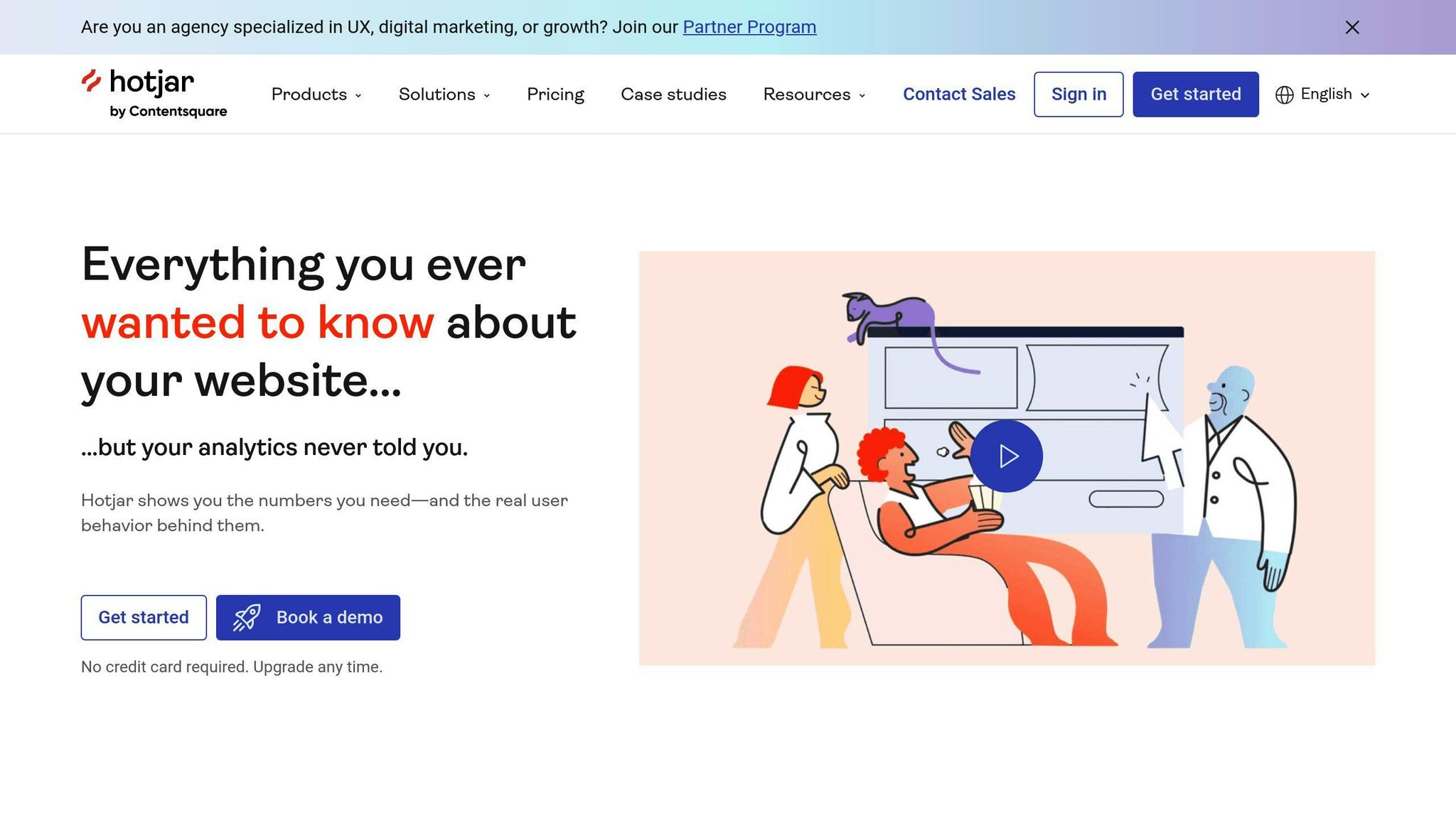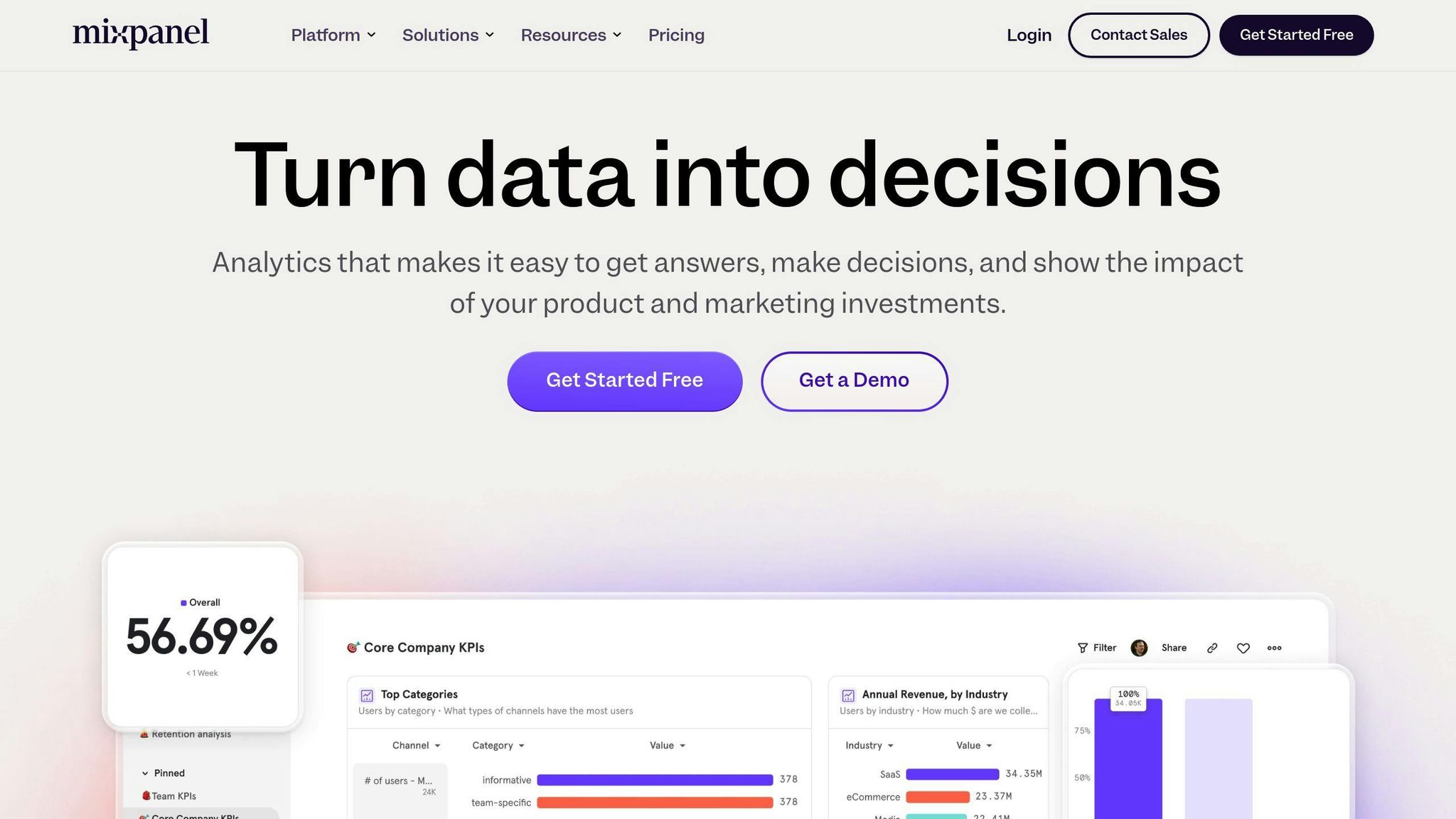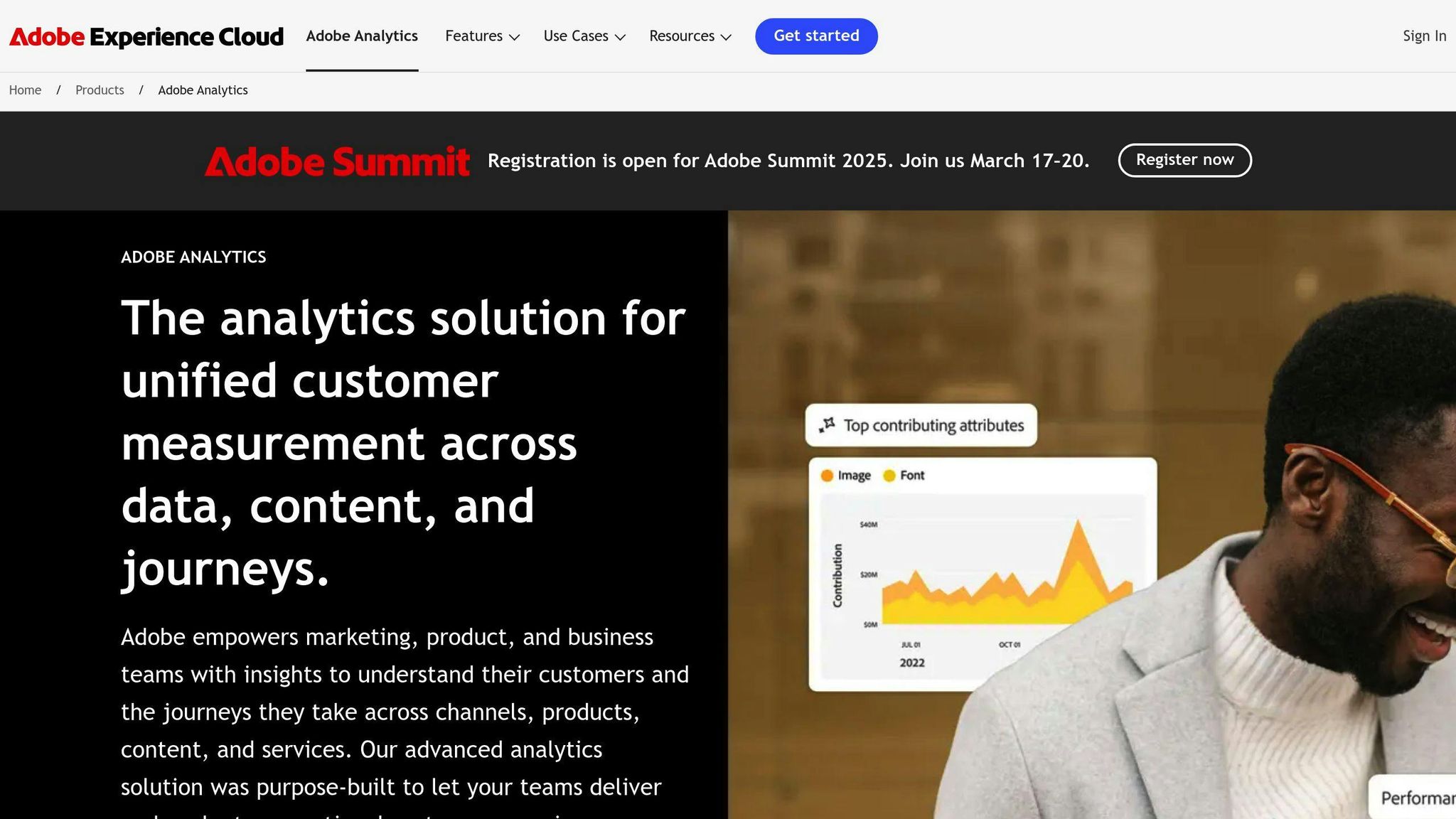Choosing the right web analytics reporting tool is crucial for new businesses aiming to understand and improve their online presence. These tools offer insights into website traffic, user behavior, conversion rates, and more, helping businesses make informed decisions. Here’s a quick overview to help you pick the best tool for your needs:
- Real-Time Data Analysis: Instant insights into website performance.
- In-Depth User Behavior Tracking: Understand how visitors interact with your site.
- Conversion Tracking & Goal Setting: Measure how well your site converts visitors into customers.
- Integrations & API Access: Ensure compatibility with other tools you use.
- Data Privacy & Ownership: Keep your and your users' data safe.
We also compare popular tools like Google Analytics, Hotjar, Mixpanel, Adobe Analytics, and Matomo on these features, pros, and cons to help you make an informed choice.
| Tool | Pros | Cons |
|---|---|---|
| Google Analytics | Free, feature-rich, integrates well with Google products | Can be complex, privacy concerns |
| Hotjar | Visual insights into user behavior, easy to use | Limited goal tracking, can get expensive |
| Mixpanel | Real-time updates, flexible data analysis | Steep learning curve, can be costly |
| Adobe Analytics | Comprehensive features, integrates with Adobe products | Expensive, not the easiest to use |
| Matomo | Privacy-focused, open-source, customizable | Requires technical know-how, updates may lag in free version |
Remember to consider your business needs, budget, and technical capabilities when choosing a web analytics tool. Trying out a few tools with free trials can also help you find the best fit for your business.
Key Features to Look for in Web Analytics Reporting Tools
When you're starting a business, picking the right tool to understand your website can make a big difference. Here are five important things to look for:
1. Real-Time Data Analysis
It's super helpful to see your website's data right away. This means you can quickly spot and fix problems or see if the changes you made are working. Think of it as watching your website's heartbeat, making sure everything's running smoothly.
2. In-Depth User Behavior Tracking
Knowing how many people visit your site is just the start. It's more important to see what they do on your site, like where they click and how far they scroll. This helps you make your website better and more interesting for your visitors.
3. Conversion Tracking & Goal Setting
It's crucial to know if your website is good at turning visitors into customers. By setting goals and tracking how well your site meets them, you can find out where you're losing customers and work on fixing those spots.
4. Integrations & API Access
As your business grows, you'll use more tools. Make sure your web analytics tool can work with other software you use, like email or chat services. Being able to customize your data with API access is also a big plus.
5. Data Privacy & Ownership
With all the rules about data privacy, you need to be sure your tool is clear about how it uses data. It's important that you own your data and know it's being kept safe. This helps you stay out of trouble and keeps your visitors' trust.
Comparative Analysis of Popular Web Analytics Reporting Tools
1. Google Analytics

Real-time Data Analysis
Google Analytics lets you see what's happening on your website right now. You can check how many people are visiting and what they're doing. This is great for spotting problems fast or seeing if changes you made are working. But, the free version doesn't let you change these real-time reports much.
User Behavior Tracking
Google Analytics helps you understand what visitors do on your site, like which pages they look at, where they click, and how long they stay. You can also see where your visitors come from and which pages they visit first or last.
Conversion Tracking
Google Analytics lets you set up goals to track if visitors do what you want them to do, like buying something. You have to set this up yourself, but it's really helpful to see where you might be losing customers.
Integration Capabilities
Google Analytics works well with other Google tools and many other tools you might use. If you want to do more with your data, like taking it out for a deeper look, you'll need some tech skills or a developer's help.
Privacy and Data Ownership
Google Analytics has made its privacy better, but Google can still see the data it collects from your site. You own your data, but you're not the only one who can see it.
2. Hotjar

Real-time Data Analysis
Hotjar lets you see right away where people are clicking and moving on your website with something called heatmaps. This is like watching what people do on your site as it happens, helping you spot problems or chances to make your site better quickly. But, Hotjar doesn't give you instant updates on things like how many people visit your site or if they're buying anything.
User Behavior Tracking
Hotjar is really good at showing you how people use your site with heatmaps, scroll maps, and videos of their visits. This means you can see where they click, how much of your page they read, and how they move their mouse. This kind of info gives you a close-up look at what people do on your site.
Conversion Tracking
Hotjar doesn't have tools to track if people are doing what you hope, like buying something, directly. You'll need to use a different tool for keeping an eye on your goals and how well you're reaching them.
Integration Capabilities
Hotjar works with other tools you might be using, like Google Analytics or Mixpanel. This means you can add things from Hotjar, like feedback boxes or videos of user visits, to these other tools. It helps you understand your website traffic and user behavior by connecting the dots between what people do and the numbers you see in your reports.
Privacy and Data Ownership
With Hotjar, you're in charge of your data. You can delete it whenever you want. They're also serious about keeping your data safe and follow GDPR rules. But, since Hotjar is a separate service, they can still see how people use your site.
3. Mixpanel

Real-time Data Analysis
Mixpanel gives you updates right away about how people are using your site or app. You can see important info and check if people are doing what you hope, all in real time. This means you can quickly find and fix any problems, or test out new ideas to see how they work.
User Behavior Tracking
Mixpanel tracks more than just how many people visit your site. It looks at what they do, like clicking buttons or filling out forms. You can see how users move through your site, what keeps them coming back, or why they leave. This info helps you make your site better and easier to use.
Conversion Tracking
With Mixpanel, you can keep an eye on specific actions you want visitors to take, like signing up or making a purchase. It shows you where people stop in the process, helping you figure out how to keep them moving forward.
Integration Capabilities
Mixpanel can work with over 300 other tools you might be using, like Slack or Salesforce. This means you can bring all your data together, making it easier to understand what's going on.
Privacy and Data Ownership
Mixpanel follows rules like GDPR to keep user info safe. They make sure you can delete data if you need to and let you keep and move your data whenever you want, giving you full control.
4. Adobe Analytics

Real-time Data Analysis
Adobe Analytics lets you see what's happening on your website right now, like spotting problems quickly. But, remember, the fancy features for checking things in real time might only come with the more expensive plans.
User Behavior Tracking
With Adobe Analytics, you can really get into the details of what visitors do on your site, like where they click or how far they scroll. It shows you the path visitors take and where they might get stuck or leave, which helps you make your site better.
Conversion Tracking
You can set up goals in Adobe Analytics to see if people are doing what you hope, like signing up or buying something. This helps you understand how well your website is working to get visitors to take action.
Integration Capabilities
Adobe Analytics plays nice with other Adobe tools and lots of other software you might use. This means you can mix data from different sources to get a fuller picture. Plus, if you're a data whiz, you can use APIs to dig deeper into the data.
Privacy and Data Ownership
Adobe says you own your data, and you can set rules on how long to keep it and who can see it. Your data is stored with Adobe, and they have strong security, but Adobe folks might still be able to access your data.
5. Matomo

Real-time Data Analysis
Matomo shows you what's happening on your website as it happens. You can see how many people are there right now, watch what they're doing with heatmaps and recordings, and quickly see if your changes make a difference. But, keep in mind, the quick updates might not be available in the cheaper plans.
User Behavior Tracking
Matomo gives you a close look at how visitors move around your site. It uses tools like heatmaps, session recordings, scroll maps, and form analytics to give you a clear picture. This helps you spot problems and figure out how to make your site better.
Conversion Tracking
With Matomo, you can set goals to track important actions, like signing up for newsletters, filling out contact forms, or buying something. It shows you where visitors stop and leave, so you can find and fix any issues.
Integration Capabilities
Matomo is open-source, meaning it's made for tech-savvy folks to tweak and connect with other tools. It has over 100 plugins for linking up with different online services, making it flexible.
Privacy and Data Ownership
Matomo puts privacy first and keeps your data safe. Because you host it yourself, you're in full control of your data. It sticks to privacy laws like GDPR, letting you handle visitor data responsibly.
sbb-itb-74f63ba
Pros and Cons of Each Tool
Picking the right tool to check out how your website is doing can be tricky. Each one has good things and not-so-good things about it. Let's look at 5 popular tools and what makes them cool or a bit of a hassle:
| Tool | Pros | Cons |
|---|---|---|
| Google Analytics | \- Free | |
| \- Lots of features | ||
| \- Works well with other Google stuff | ||
| \- You can change it a lot | \- Might be hard for newbies | |
| \- Some worries about how they handle your data | ||
| Hotjar | \- Shows you what users do in a cool way | |
| \- Simple to start using | ||
| \- Follows privacy rules | \- Not great for tracking goals | |
| \- Costs more if you need more features | ||
| Mixpanel | \- Updates right away | |
| \- Lets you look at data in different ways | ||
| \- Works with lots of other tools | \- Takes time to learn | |
| \- Gets expensive if you use it a lot | ||
| Adobe Analytics | \- Tons of features and you can change it a lot | |
| \- Works with other Adobe products | ||
| \- Good for lots of data | \- Costs a lot for the full version | |
| \- Not the easiest to set up or use | ||
| Matomo | \- You run it yourself and it's free | |
| \- Puts privacy first | ||
| \- Lots of add-ons | \- You need to know a bit about tech to manage it | |
| \- Free version doesn't update right away |
When you're deciding, think about a few things:
- Cost: Some tools are free, but others can get pricey. Keep your budget in mind.
- Ease of use: Tools like Hotjar are easy to start with, but others might need you to learn a bit more. Think about what you and your team can handle.
- Privacy practices: If keeping data safe is important, tools like Matomo that you manage yourself are a good choice.
- Features and customization: Decide what's really important for you to know about your website and what's just nice to have.
Figuring out what you really need and how much you can spend can help you pick. Then, you can try a few to see which one fits your business best. It's a good idea to mix different ways of looking at your website to get the full picture.
Case Studies or Success Stories
Here are some real stories about new companies that used tools to understand their website better. They learned how to make their sites work better for their visitors, which helped them grow:
Fashion Startup Increases Conversion Rate by 12%
A new online fashion store wasn't making as many sales as they hoped, even though people were visiting their site. They started using Hotjar and found out that their checkout process was confusing people.
"By watching how people acted on our site with Hotjar, we saw where they were getting stuck. We made our checkout simpler, and quickly saw a 12% jump in sales."
Key Takeaway: Watching how users behave on the site showed where the problems were. Fixing these problems helped sell more.
SaaS Company Boosts Free Trial Signups by 8x
A company selling software to other businesses saw that not many visitors were signing up for their free trial. After they used Mixpanel, they realized the signup button was too hard to see. Making the button stand out more led to 8 times more people signing up.
"We had visitors but not many were trying our product. Mixpanel helped us see the issue and fix it quickly, which really worked."
Key Takeaway: Keeping track of where visitors stop and leave helped find and fix signup issues.
Agency Increases Client Retention by 19%
A company that helps other businesses with their online marketing had trouble showing their clients what was happening with their websites. They made custom dashboards with Matomo for each client, showing them important info easily. This approach helped keep 19% more clients over two years.
"Letting our clients see their website data anytime made them feel more in charge and opened up more chances for us to help them improve."
Key Takeaway: Making it easy for clients to see their website's important numbers helped keep them happy and staying longer.
Conclusion
When you're starting a business and need to understand how your website is doing, picking the right tool to look at your website's data is super important. There are a bunch of tools out there, but you have to think about what matters most for your business. Here's what to keep in mind:
Real-time analysis: It's helpful to see what's happening on your website right away. This helps you fix any problems fast.
In-depth tracking: Choose a tool that shows you exactly how people are using your website, like where they click or how far they scroll. This can help you make your site better for your visitors.
Conversion and goal tracking: It's important to check if your website is helping you reach your goals, like making sales or getting sign-ups. A good tool will help you see how well you're doing.
Integrations: If you use other software for your business, find a tool that works well with them. This makes it easier to understand your data.
Privacy practices and data ownership: Make sure you pick a tool that keeps your data safe and lets you control it. This is really important.
Affordability: You don't want to spend too much money at the start. Look for a tool that gives you what you need without breaking the bank.
Try out a few tools with free trials to see which one fits your business best. Over time, you'll see which tool helps you make smart decisions for your website. With the right tool, you can use your website's data to help your business grow.